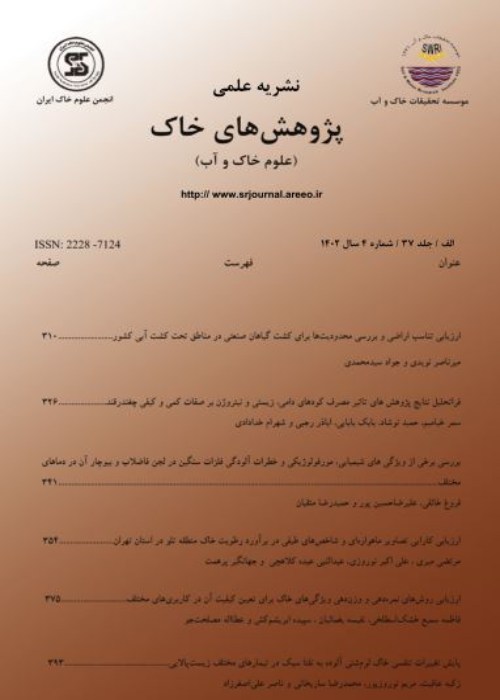Geostatistical Assessment of Spatial Variability of Some Surface Soil Properties in Arsenjan Plain
Author(s):
Abstract:
For optimum planning، utilization، and management of lands، recognition of spatial variability of soil properties is necessary. This research was conducted to evaluate spatial variability of soil properties in 5000 ha of Arsenjan plain in Fars province. For this purpose، soil salinity، pH، particle size percentage، sodium، potassium، and organic carbon (OC) were measured on a systematic squared grid pattern with 500*500 m at 185 sites. For these variables، the best variogram model among linear، exponential، Gaussian، and spherical models with the highest R2 and the least error was determined using GS+، and ArcGIS software. The best interpolation method was also selected among kriging، co-kriging، and inverse distance weighted (IDW) methods for estimating data in non-sampled areas. To select desirable interpolation method، cross validation was used by statistical parameters of mean bias error، mean absolute error، mean square error، and root mean square error. The soil properties spatial variation maps were obtained with the best interpolation method. Results showed that soil properties had high variability. Soil salinity varied from 0. 44 to 11. 6 dS per meter، clay from 3. 4% to 42%، silt from 5. 8% to 93. 1%، and sand from 2. 4% to 79%. Soil texture had different classes at the study area، and there was significant correlation between soil properties. The best model for the single semi-variogram of soil salinity، pH، and clay percent was the exponential model; for silt and sand percent it was Gaussian model، and for OM the spherical model. In most cases، soil properties variogram models had small amount of nugget effect، high spatial correlation and high R2، and low amount of RSS. Although cross variogram parameters had acceptable amounts، soil variable kriging method was the unbiased estimator for most soil variables compared to co-kriging and IDW methods. The best interpolation method for silt percent was IDW، and for the other soil properties، kriging was the best one. Soil salinity and pH increased from north to south، especially toward south western. Clay percent، and OC decreased from west to east، and silt percent had the maximum amount in the center and east of the plain. Soil sodium and potassium had approximately similar trend، increasing from north to south and were affected by the low quality of irrigation water. This indicated that soil degradation and salinization has been occurring in the south part of the plain. Soil degradation and salinization is in progress and is a serious threat for the soil and water resource of this plain in the future.
Language:
Persian
Published:
Iranian Journal of Soil Research, Volume:29 Issue: 1, 2015
Pages:
59 to 69
magiran.com/p1412549
دانلود و مطالعه متن این مقاله با یکی از روشهای زیر امکان پذیر است:
اشتراک شخصی
با عضویت و پرداخت آنلاین حق اشتراک یکساله به مبلغ 1,390,000ريال میتوانید 70 عنوان مطلب دانلود کنید!
اشتراک سازمانی
به کتابخانه دانشگاه یا محل کار خود پیشنهاد کنید تا اشتراک سازمانی این پایگاه را برای دسترسی نامحدود همه کاربران به متن مطالب تهیه نمایند!
توجه!
- حق عضویت دریافتی صرف حمایت از نشریات عضو و نگهداری، تکمیل و توسعه مگیران میشود.
- پرداخت حق اشتراک و دانلود مقالات اجازه بازنشر آن در سایر رسانههای چاپی و دیجیتال را به کاربر نمیدهد.
In order to view content subscription is required
Personal subscription
Subscribe magiran.com for 70 € euros via PayPal and download 70 articles during a year.
Organization subscription
Please contact us to subscribe your university or library for unlimited access!


